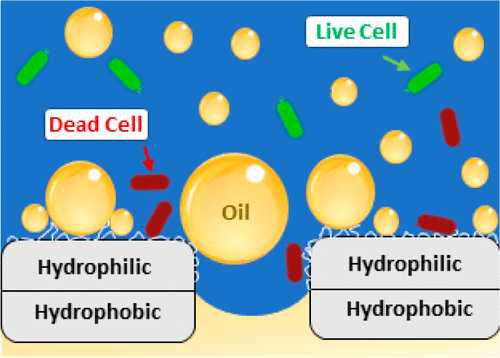当前位置:
X-MOL 学术
›
ACS Appl. Polym. Mater.
›
论文详情
Our official English website, www.x-mol.net, welcomes your
feedback! (Note: you will need to create a separate account there.)
Antimicrobial Janus Filters that Break Oil-in-Water Emulsions and Separate Oil
ACS Applied Polymer Materials ( IF 4.4 ) Pub Date : 2020-11-25 , DOI: 10.1021/acsapm.0c01091 Morgan J. Lehtinen 1 , Guojun Liu 1 , Jiafu Wu 1 , A. R. Ola Pasternak 1
ACS Applied Polymer Materials ( IF 4.4 ) Pub Date : 2020-11-25 , DOI: 10.1021/acsapm.0c01091 Morgan J. Lehtinen 1 , Guojun Liu 1 , Jiafu Wu 1 , A. R. Ola Pasternak 1
Affiliation

|
Separation of oil from emulsions is industrially important. Existing Janus filters that bear a de-emulsifier on one surface and a hydrophobic polymer on the opposite side can break oil-in-water emulsions and selectively separate the coalesced oil. This paper reports a Janus filter that possesses the additional function of being antimicrobial. This filter is prepared by aero-spraying one side of a cotton fabric with a solution of a copolymer containing the hydrophobic poly(dimethylsiloxane) (PDMS) and soaking the other side in a solution containing a copolymer of dimethylaminoethyl methacrylate (DMAEMA). The fabric is then baked in an oven to cross-link the polymers around the cotton fibers. The DMAEMA-bearing side is further reacted with benzyl bromide to produce quaternized DMAEMA. The latter coalesces oil droplets stabilized by an ionic surfactant most likely via two mechanisms: fusion of different oil droplets around the charged fibers and fusion of overlapping oil droplets adsorbed on the fibers. The adsorption occurs probably due to the displacing of the surfactant molecules on the droplet surfaces by the surfactant-like quaternized DMAEMA units. The coalesced oil is then drawn to the hydrophobic PDMS side that repels water and gets separated from the emulsion. Moreover, the quaternary amine is antimicrobial, killing the model bacterium E. coli under various conditions, and impedes filter contamination by microorganisms. These trifunctional filters with further performance improvement may find practical applications.
中文翻译:

打破水包油乳状液并分离油的抗菌Janus过滤器
从乳液中分离油在工业上很重要。现有的Janus过滤器在一个表面上带有去乳化剂,而在另一侧带有疏水性聚合物,可以破坏水包油乳液并选择性地分离聚结的油。本文报道了Janus过滤器,该过滤器具有抗菌功能。通过用含有疏水性聚二甲基硅氧烷(PDMS)的共聚物溶液对棉布的一侧进行空气喷涂,然后将另一侧浸泡在含有甲基丙烯酸二甲基氨基乙基酯(DMAEMA)的溶液中来制备这种过滤器。然后将织物在烤箱中烘烤,以使聚合物围绕棉纤维交联。带有DMAEMA的一面进一步与苄基溴反应生成季铵化DMAEMA。后者通过离子表面活性剂稳定化的油滴很可能通过两种机制聚结:带电纤维周围不同油滴的融合和吸附在纤维上的重叠油滴的融合。吸附的发生可能是由于表面活性剂分子的季铵化DMAEMA单元将表面活性剂分子转移到了液滴表面上。然后将聚结的油吸入疏水性PDMS一侧,该侧排斥水并从乳液中分离出来。而且,季胺具有抗菌作用,可以杀死模型细菌 吸附的发生可能是由于表面活性剂分子的季铵化DMAEMA单元将表面活性剂分子转移到了液滴表面上。然后将聚结的油吸入疏水性PDMS一侧,该侧排斥水并从乳液中分离出来。而且,季胺具有抗菌作用,可以杀死模型细菌 吸附的发生可能是由于表面活性剂分子的季铵化DMAEMA单元将表面活性剂分子转移到了液滴表面上。然后将聚结的油抽到疏水性PDMS一侧,以排斥水并从乳液中分离出来。而且,季胺具有抗菌作用,可以杀死模型细菌大肠杆菌在各种条件下都会阻止过滤器被微生物污染。这些性能进一步提高的三功能滤波器可能会找到实际应用。
更新日期:2020-12-11
中文翻译:

打破水包油乳状液并分离油的抗菌Janus过滤器
从乳液中分离油在工业上很重要。现有的Janus过滤器在一个表面上带有去乳化剂,而在另一侧带有疏水性聚合物,可以破坏水包油乳液并选择性地分离聚结的油。本文报道了Janus过滤器,该过滤器具有抗菌功能。通过用含有疏水性聚二甲基硅氧烷(PDMS)的共聚物溶液对棉布的一侧进行空气喷涂,然后将另一侧浸泡在含有甲基丙烯酸二甲基氨基乙基酯(DMAEMA)的溶液中来制备这种过滤器。然后将织物在烤箱中烘烤,以使聚合物围绕棉纤维交联。带有DMAEMA的一面进一步与苄基溴反应生成季铵化DMAEMA。后者通过离子表面活性剂稳定化的油滴很可能通过两种机制聚结:带电纤维周围不同油滴的融合和吸附在纤维上的重叠油滴的融合。吸附的发生可能是由于表面活性剂分子的季铵化DMAEMA单元将表面活性剂分子转移到了液滴表面上。然后将聚结的油吸入疏水性PDMS一侧,该侧排斥水并从乳液中分离出来。而且,季胺具有抗菌作用,可以杀死模型细菌 吸附的发生可能是由于表面活性剂分子的季铵化DMAEMA单元将表面活性剂分子转移到了液滴表面上。然后将聚结的油吸入疏水性PDMS一侧,该侧排斥水并从乳液中分离出来。而且,季胺具有抗菌作用,可以杀死模型细菌 吸附的发生可能是由于表面活性剂分子的季铵化DMAEMA单元将表面活性剂分子转移到了液滴表面上。然后将聚结的油抽到疏水性PDMS一侧,以排斥水并从乳液中分离出来。而且,季胺具有抗菌作用,可以杀死模型细菌大肠杆菌在各种条件下都会阻止过滤器被微生物污染。这些性能进一步提高的三功能滤波器可能会找到实际应用。











































 京公网安备 11010802027423号
京公网安备 11010802027423号